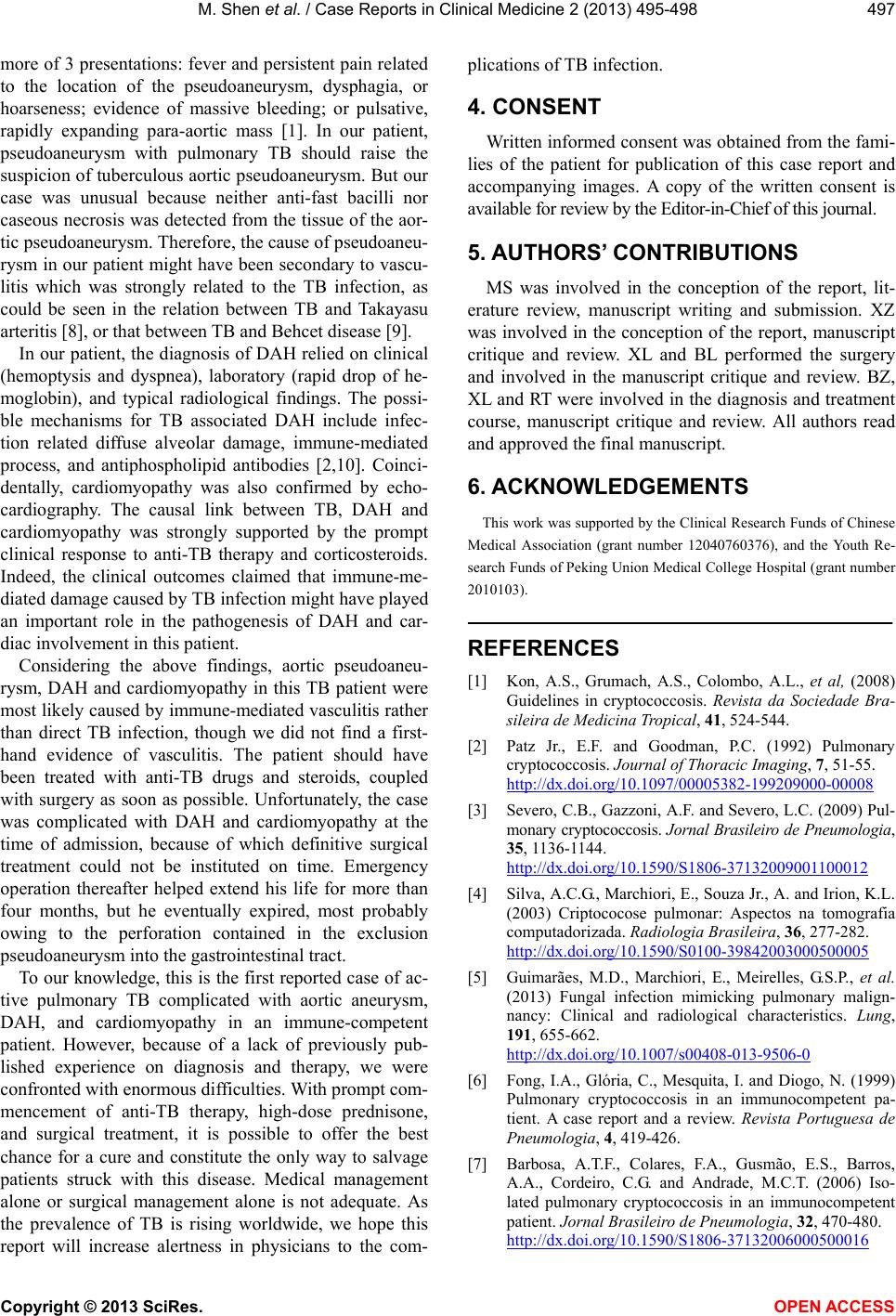
M. Shen et al. / Case Reports in Clinical Medicine 2 (2013) 495-498 497
more of 3 presentations: fever and persistent pain related
to the location of the pseudoaneurysm, dysphagia, or
hoarseness; evidence of massive bleeding; or pulsative,
rapidly expanding para-aortic mass [1]. In our patient,
pseudoaneurysm with pulmonary TB should raise the
suspicion of tuberculous aortic pseudoaneurysm. But our
case was unusual because neither anti-fast bacilli nor
caseous necrosis was detected from the tissue of the aor-
tic pseudoaneurysm. Therefore, the cause of pseudoaneu-
rysm in our patient might have been secondary to vascu-
litis which was strongly related to the TB infection, as
could be seen in the relation between TB and Takayasu
arteritis [8], or that between TB and Behcet disease [9].
In our patient, the diagnosis of DAH relied on clinical
(hemoptysis and dyspnea), laboratory (rapid drop of he-
moglobin), and typical radiological findings. The possi-
ble mechanisms for TB associated DAH include infec-
tion related diffuse alveolar damage, immune-mediated
process, and antiphospholipid antibodies [2,10]. Coinci-
dentally, cardiomyopathy was also confirmed by echo-
cardiography. The causal link between TB, DAH and
cardiomyopathy was strongly supported by the prompt
clinical response to anti-TB therapy and corticosteroids.
Indeed, the clinical outcomes claimed that immune-me-
diated damage caused by TB infection might have played
an important role in the pathogenesis of DAH and car-
diac involvement in this patient.
Considering the above findings, aortic pseudoaneu-
rysm, DAH and cardiomyopathy in this TB patient were
most likely caused by immune-mediated vasculitis rather
than direct TB infection, though we did not find a first-
hand evidence of vasculitis. The patient should have
been treated with anti-TB drugs and steroids, coupled
with surgery as soon as possible. Unfortunately, the case
was complicated with DAH and cardiomyopathy at the
time of admission, because of which definitive surgical
treatment could not be instituted on time. Emergency
operation thereafter helped extend his life for more than
four months, but he eventually expired, most probably
owing to the perforation contained in the exclusion
pseudoaneurysm into the gastrointestinal tract.
To our knowledge, this is the first reported case of ac-
tive pulmonary TB complicated with aortic aneurysm,
DAH, and cardiomyopathy in an immune-competent
patient. However, because of a lack of previously pub-
lished experience on diagnosis and therapy, we were
confronted with enormous difficulties. With prompt com-
mencement of anti-TB therapy, high-dose prednisone,
and surgical treatment, it is possible to offer the best
chance for a cure and constitute the only way to salvage
patients struck with this disease. Medical management
alone or surgical management alone is not adequate. As
the prevalence of TB is rising worldwide, we hope this
report will increase alertness in physicians to the com-
plications of TB infection.
4. CONSENT
Written informed consent was obtained from the fami-
lies of the patient for publication of this case report and
accompanying images. A copy of the written consent is
available for review by the Editor-in-Chief of this journal.
5. AUTHORS’ CONTRIBUTIONS
MS was involved in the conception of the report, lit-
erature review, manuscript writing and submission. XZ
was involved in the conception of the report, manuscript
critique and review. XL and BL performed the surgery
and involved in the manuscript critique and review. BZ,
XL and RT were involved in the diagnosis and treatment
course, manuscript critique and review. All authors read
and approved the final manuscript.
6. ACKNOWLEDGEMENTS
This work was supported by the Clinical Research Funds of Chinese
Medical Association (grant number 12040760376), and the Youth Re-
search Funds of Peking Union Medical College Hospital (grant number
2010103).
REFERENCES
[1] Kon, A.S., Grumach, A.S., Colombo, A.L., et al, (2008)
Guidelines in cryptococcosis. Revista da Sociedade Bra-
sileira de Medicina Tropical, 41, 524-544.
[2] Patz Jr., E.F. and Goodman, P.C. (1992) Pulmonary
cryptococcosis. Journal of Thoracic Imaging, 7, 51-55.
http://dx.doi.org/10.1097/00005382-199209000-00008
[3] Severo, C.B., Gazzoni, A.F. and Severo, L.C. (2009) Pul-
monary cryptococcosis. Jornal Brasileiro de Pneumologia,
35, 1136-1144.
http://dx.doi.org/10.1590/S1806-37132009001100012
[4] Silva, A.C.G., Marchiori, E., Souza Jr., A. and Irion, K.L.
(2003) Criptococose pulmonar: Aspectos na tomografia
computadorizada. Radiologia Brasileira, 36, 277-282.
http://dx.doi.org/10.1590/S0100-39842003000500005
[5] Guimarães, M.D., Marchiori, E., Meirelles, G.S.P., et al.
(2013) Fungal infection mimicking pulmonary malign-
nancy: Clinical and radiological characteristics. Lung,
191, 655-662.
http://dx.doi.org/10.1007/s00408-013-9506-0
[6] Fong, I.A., Glória, C., Mesquita, I. and Diogo, N. (1999)
Pulmonary cryptococcosis in an immunocompetent pa-
tient. A case report and a review. Revista Portuguesa de
Pneumologia, 4, 419-426.
[7] Barbosa, A.T.F., Colares, F.A., Gusmão, E.S., Barros,
A.A., Cordeiro, C.G. and Andrade, M.C.T. (2006) Iso-
lated pulmonary cryptococcosis in an immunocompetent
patient. Jornal Brasileiro de Pneumologia, 32, 470-480.
http://dx.doi.org/10.1590/S1806-37132006000500016
Copyright © 2013 SciRes. OPEN ACCESS